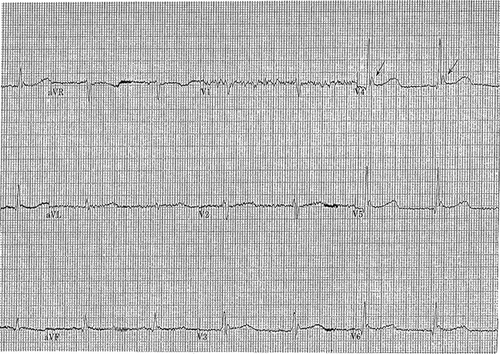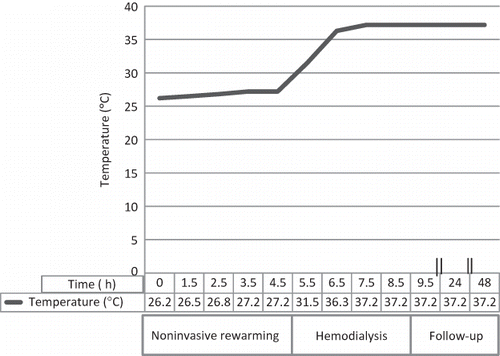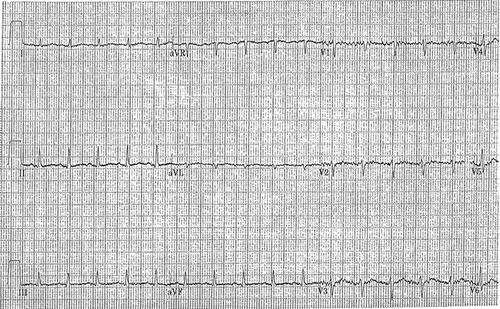Abstract
Deep accidental hypothermia (body temperature below 28°C) is rare. Even with modern supportive care of active external and internal rewarming techniques it is associated with a high mortality rate. We report the early and successful use of hemodialysis (HD) for active rewarming of a middle-aged alcoholic man with severe deep accidental hypothermia after failure of initial efforts of rewarming using conventional strategies. This case report and review of the literature highlights the advantages and the challenges of using HD in this setting and suggests a potential role for HD in the routine management of severe hypothermia in the absence of circulatory arrest.
INTRODUCTION
Hypothermia is defined as a core body temperature of less than 35°C and is divided into mild hypothermia (32–35°C), moderate hypothermia (28–32°C), and severe hypothermia (<28°C).Citation1 Approximately 600 people die of hypothermia each year in the United States.Citation2 Mortality rates due to severe hypothermia vary between 12% and 80% in published series, depending on age, comorbidities, intoxication, cause of hypothermia, and delays in treatment.Citation3,4
The typical initial clinical manifestations of hypothermia are lethargy, confusion, tachycardia, tachypnea, and shivering. In more severe hypothermia, impaired judgment, ataxia, diminished reflexes, hypotension, bradycardia, decreased respiratory rate, delirium, and coma may occur. Biochemical and hematological investigation may reveal evidence of hypo- or hyperkalemia, renal impairment secondary to rhabdomyolysis or ischemic acute tubular necrosis, and coagulopathy because enzymes in the coagulation cascade are temperature dependent. However, results of coagulation studies are frequently normal as the blood sample is heated to 37°C (98.6°F) before analysis.Citation5 Electrocardiogram (EKG) abnormalities include prolongation of PR, QT, and QRS intervals, atrial fibrillation, second- or third-degree heart block, and Osborn waves (positive deflections occurring at the junction between the QRS complex and the ST segment). Ventricular fibrillation and asystole occur as preterminal events.Citation6
Several case series have suggested that the rate of rewarming is an important prognostic factor for mortality in patients with severe hypothermia. Failure to rewarm a patient within 12 h is associated with increased mortality.Citation3,7–9 Treatment modalities for hypothermia range from noninvasive, passive external warming techniques (e.g., removal of cold, wet clothing, movement to a warm environment) to active external rewarming (e.g., insulation with warm blankets) to active internal rewarming (e.g., warmed intravenous fluid infusions, heated humidified oxygen, body cavity lavage, and extracorporeal blood warming). The decision to use passive, active external, or active internal rewarming techniques and the specific technique should be based on several clinical parameters including degree of hypothermia, presence or absence of cardiopulmonary arrest, and on available resources.Citation10
Extracorporeal techniques can be used to directly rewarm blood in patients who do not rewarm with less invasive active internal rewarming techniques or those with completely frozen extremities or severe rhabdomyolysis with hyperkalemia. Several extracorporeal techniques have been used to directly rewarm blood: cardiopulmonary bypass (CPB),Citation11,12 continuous arteriovenous rewarming (CAVR),Citation13 continuous venovenous hemofiltration (CVVH),Citation14 continuous venovenous hemodiafiltration (CVVHDF),Citation15 and hemodialysis (HD).Citation16–20 Currently, an active internal rewarming strategy for patients with severe hypothermia has not been established. HD is an attractive modality for active internal rewarming given its wide availability and its ability to manage associated metabolic derangements as well as allow infusion of warmed IV fluid. There are only two reports on the use of HD in hypothermic patients without renal failureCitation17,18 and three with renal failure in the literature.Citation16,19,20 These case reports offer limited information on the actual indications, timing, and details of the procedure of HD. We describe a case of severe hypothermia in a patient without renal failure who was successfully treated with HD after initial failed attempts with active external and internal rewarming. We provide details of the amount of time spent using other strategies prior to the initiation of HD, the rewarming rate off and on HD, dialysate bath temperature, hours on HD, and requirement for pressors. In addition, we summarized the available data on prior use of HD for rewarming in hypothermia.
CASE REPORT
A 45-year-old homeless man was brought to the medical emergency department after he was found unresponsive lying on the street. He had a history of chronic alcohol abuse and multiple traumatic injuries due to falls. On examination he was lethargic with core body temperature obtained by rectal thermometer (Welch Allyn; model Sure Temp Plus, Skaneateles Falls, NY, USA) of 26.2°C, blood pressure of 110/73 mmHg, heart rate of 50 beats/min, and respiratory rate of 8/min.
His physical examination was significant for old healed scars on his left knee and right ankle, a recent bruise on his forehead, cyanosed hands, and mild edema of bilateral lower extremities up to the knees. He was awake but disoriented to person, time, and place. EKG examination revealed sinus bradycardia of 55 beats/min and typical Osborn waves in anterior leads (). Initial laboratory tests revealed WBC of 2.2 K/mm3, acute respiratory acidosis with pH of 7.27, pCO2 of 62 mmHg, HCO3 of 27 mmol/L, pO2 of 150 mmHg on 40% face mask, BUN of 9 mg/dL, serum creatinine of 0.4 mg/dL, creatine kinase of 3230 U/L, potassium of 3.2 meq/L, and osmol gap of 110 mosm/kg (measured plasma osmolality-calculated plasma osmolarity). We calculated plasma osmolarity using the following formula: 2[Na+] + [Glucose]/18 + [BUN]/2.8. His serum ethanol level was 448 mg/dL, which almost completely accounts for the increase in osmol gap; serum toxicology screen was otherwise negative. Urine drug screen was positive for benzodiazepines and ethanol. Computed tomography (CT) of his head and cervical spine were unremarkable for signs of traumatic injury.
The patient received intravenous thiamine, naloxone, and empiric piperacillin/tazobactam for possible sepsis in a hypothermic patient. Blood cultures drawn on admission were subsequently reported as negative. He was immediately started on active external and internal rewarming in the form of a warming blanket, warmed humidified oxygen (39°C) inhalation via face mask, and warmed intravenous fluid (42°C), in total 1300 mL. There was no indication for intubation. His core temperature rose only 1.06°C (from 26.22°C to 27.28°C) in 4.5 h despite those measures ().
In view of failed less-invasive rewarming techniques and ethanol intoxication, which made it difficult to assess his mental status, HD was used as an extracorporeal blood rewarming technique. A temporary HD catheter was placed in the femoral vein to avoid irritation of the heart and induction of arrhythmias.
Temperature of the HD machine was set at 37°C; blood flow was 300 mL/min and dialysate flow was 500 mL/min. A dialysate bath containing potassium 3 meq/L was used and no fluid was removed.
Initially during HD the patient’s systolic blood pressure dropped to 72 mmHg, which was supported with norepinephrine infusion for 2 h but then stabilized without vasopressor support. His temperature reached 97.3°F (36.3°C) in 2 h of starting HD (). The HD was stopped after a total of 4 h, when the patient became more alert and responsive and was able to state his name. A repeat EKG performed 1 h after completion of HD demonstrated resolution of the Osborn waves (). He remained disoriented to place and time and was started on the Librium protocol later that evening as treatment for potential alcohol withdrawal. Over the ensuing 48 h the patient’s temperature remained at 37°C, and he was transferred from the ICU to the medical floor where his mental status returned to baseline. The patient was discharged on the fifth day after admission.
DISCUSSION
Our case demonstrates the efficacy of initiating HD early in the treatment for severe hypothermia. HD was started after 4.5 h of unsuccessfully attempting other strategies. Utilizing a standard bath temperature achieved a rewarming rate of 3.3°C/h, allowing normalization of the patient’s body temperature within 2 h after initiating HD. Although the patient was initially hypotensive, hemodynamic instability may have been related to the HD procedure itself, not necessarily to the rapid rewarming rate. He did well with a short course of pressor support.
Several other extracorporeal techniques have been used to directly rewarm blood in hypothermic patients. Although a case series suggested that in the presence of cardiac arrest CPB is likely the best rewarming method for hypothermia,Citation21 CPB is restricted to specialized centers, is highly invasive, and has a high risk of complications.Citation11 The relative benefits and harms of the rapid blood rewarming rates achieved by CPB (up to 9.5°C/h)Citation12 have not been established in patients without cardiac arrest. Rapid rewarming of victims of accidental hypothermia can cause a fall in cardiac output with a sudden drop of blood pressure, a condition known as rewarming shock. A maintained low cardiac output during and after rewarming is associated with a fatal outcome. The pathogenesis of this phenomenon is controversial. Some studies suggest there is reduced contractile function combined with changes in myocardial metabolism suggesting the myocardial dysfunction seen in rewarming shares common mechanisms with postischemic stunning. Other potential pathophysiological mechanisms include alterations in capillary function, changes in intra- and extravascular volume homeostasis, and alterations in autonomic function.Citation22 In addition to the risks and unavailability of CPB, benefits of HD over CPB include the ability to correct electrolyte and acid–base disturbances that often complicate hypothermia even in the absence of renal failure and the ability to replace heparin by normal saline infusion or other local anticoagulants to avoid the use of systemic anticoagulation in situations of trauma or hemorrhage that may complicate accidental hypothermia. Therefore, HD is more advantageous than CPB in the immediate management of patients with severe hypothermia who are not in cardiac arrest. CAVR, CVVH, and CVVHD are often less available in community hospitals than HD and offer no benefits over HD. Moreover, CAVR adds the disadvantage of requiring an arterial line.
Peritoneal dialysis (PD) has been more widely used, based on more than 40 published reports.23 These cases were mainly published in the 1970s and 1980s, mostly in countries outside of the United States. The choice of PD versus HD in those cases likely reflects available institutional resources and expertise. Today, in most institutions, placement of a temporary central catheter for HD would be easier to achieve than placement of a temporary or permanent PD catheter as physicians in many disciplines place central catheters. In contrast, PD catheter placement requires a trained surgeon or nephrologist.
HD is an extracorporeal technique that directly warms the body core and is more effective than heated oxygen, warmed IV fluids, bladder irrigation, and peritoneal lavage.Citation20 Thoracic or peritoneal lavage is slow and carries the risk of bowel perforation or pneumothorax; therefore use in the patient with severe hypothermia is recommended only if extracorporeal blood warming is unavailable.
Although HD is an attractive method of treating severe hypothermia, a literature search revealed minimal reported use of HD to treat hypothermia ( and ). There are five reported cases of patients who were treated with HD for hypothermia,Citation16–20 three of whom had renal failure.Citation16,19,20 There is limited data in the treatment of hypothermia concerning the time to initiate HD and details on the actual procedure. On review of the five cases ( and ) the time prior to initiating dialysis in which less-invasive techniques were used varied from less than 1 h to greater than 7 h. In all cases where the increase in temperature was noted it was minimal prior to HD (0.5–1.06°C). In two previous cases and in our case the temperature of the dialysis bath was noted. In one previous case,Citation18 a dialysate bath of 36°C was used to initiate dialysis; the temperature was decreased to 35°C due to hypotension and then increased to 36°C. It is unclear whether the hypotension was related to the temperature of the bath as the HD procedure itself can induce hypotension. In the other previous case,Citation16 a bath temperature of 40°C was used and in our case a dialysate bath of 37°C was used throughout the procedure. The average rewarming rate in the three cases was 2.6°C/h, ranging from 2.15 to 3.3°C/h. In all three cases, the patients’ temperature reached normal within 4 h, demonstrating that there is no indication to either lower or raise the temperature as a standard bath worked equally well and there may be complications when using a lower or higher dialysate bath temperature. Initiating HD early in the treatment plan and using a normal temperature bath avoided prolonged hypothermia, which can lead to increased mortality.
Table 1. Review of management of hypothermia prior to initiating hemodialysis in published case reports.
Table 2. Review of management of hypothermia after initiating hemodialysis in published case reports.
CONCLUSION
In patients with severe hypothermia, HD is a very useful technique that is underutilized. It is less invasive and more readily available than CPB and is without complications of pneumothorax or bowel perforation associated with body cavity lavage. Our case demonstrates the utility of using HD early in the treatment of severe hypothermia. The standard dialysate bath temperature allowed for a rapid rewarming rate that led to a successful outcome.
Declaration of interest: The authors report no conflicts of interest. The authors alone are responsible for the content and writing of the paper.
REFERENCES
- Giesbrecht GG. Cold stress, near drowning and accidental hypothermia: A review. Aviat Space Environ Med. 2000;71(7): 733–752.
- Centers for Disease Control and Prevention. Hypothermia-related deaths — United States, 2003. MMWR Morb Mortal Wkly Rep. 2004;53:172–173.
- Vassal T, Benoit-Gonin B, Carrat F, . Severe accidental hypothermia treated in an ICU: Prognosis and outcome. Chest. 2001;120:1998–2003.
- Granberg PO. Human physiology under cold exposure. Arctic Med Res. 1991;50(Suppl. 6):23–27.
- Rohrer MJ, Natale AM. Effect of hypothermia on the coagulation cascade. Crit Care Med. 1992;20:1402–1405.
- Aslam AF, Aslam AK, Vasavada BC, . Hypothermia: Evaluation, electrocardiographic manifestations, and management. Am J Med. 2006;119:297–301.
- Nicolas F, Nicolas G, Heurtel A, . [24 cases of accidental hypothermia] [article in French]. Anesth Analg. 1974;31:485–538.
- Danzl DF, Pozos RS, Auerbach PS, . Multicenter hypothermia survey. Ann Emerg Med. 1987;16:1042–1055.
- White JD. Hypothermia: The Bellevue experience. Ann Emerg Med. 1982;11:417–424.
- Guidelines 2000 for cardiopulmonary resuscitation and emergency cardiovascular care. Part 8: Advanced challenges in resuscitation: Section 3: Special challenges in ECC. Hypothermia. The American Heart Association in collaboration with the International Liaison Committee on Resuscitation. Circulation. 2000;102:I-229–I-232.
- Mair P, Schwarz B, Kornberger E, . Case 5-1997. Successful resuscitation of a patient with severe accidental hypothermia and prolonged cardiocirculatory arrest using cardiopulmonary bypass. J Cardiothorac Vasc Anesth. 1997;11:901–904.
- Shann KG, Likosky DS, Murkin JM, . An evidence-based review of the practice of cardiopulmonary bypass in adults: A focus on neurologic injury, glycemic control, hemodilution, and the inflammatory response. J Thorac Cardiovasc Surg. 2006;132:283–290.
- Gentilello LM, Cobean RA, Offner PJ, Soderberg RW, Jurkovich GJ. Continuous arteriovenous rewarming: Rapid reversal of hypothermia in critically ill patients. J Trauma. 1992;32(3):316–327.
- Spooner K, Hassani A. Extracorporeal rewarming in a severely hypothermic patient using venovenous hemofiltration in the accident and emergency department. J Accid Emerg Med. 2000;17:422–424.
- Komatsu S, Shimomatsuya T, Kobuchi T, . Severe accidental hypothermia successfully treated by rewarming strategy using continuous venovenous hemodiafiltration system. J Trauma. 2007;62:775–776.
- Hernandez E, Praga M, Alcazar JM, . Hemodialysis for treatment of accidental hypothermia. Nephron. 1993;63: 214–216.
- Carr Jr., ME, Wolfert AI. Rewarming by hemodialysis for hypothermia: Failure of heparin to prevent DIC. J Emerg Med. 1988;6:277–280.
- Sultan N, Theakston KD, Butler R, Suri RS. Treatment of severe accidental hypothermia with intermittent hemodialysis. CJEM. 2009;11(2):174–177.
- Owda A, Osama S. Hemodialysis in management of hypothermia. Am J Kidney Dis. 2001;38:E8.
- Yokoyama M, Noto Y, Kida H. Hypothermia with acute renal failure in a patient suffering from diabetic nephropathy and malnutrition. Diabet Metab. 2000;26:145–147.
- Walpoth BH, Walpoth-Aslan BN, Mattle HP, . Outcome of survivors of accidental deep hypothermia and circulatory arrest treated with extracorporeal blood warming. N Engl J Med. 1997;337:1500–1505.
- Tveita T. Rewarming from hypothermia. Int J Circumpolar Health. 2000;59:260–266.
- Mehrotra R. Peritoneal dialysis in adult patients without end-stage renal disease. Adv Perit Dial. 2000;16:67–72.



